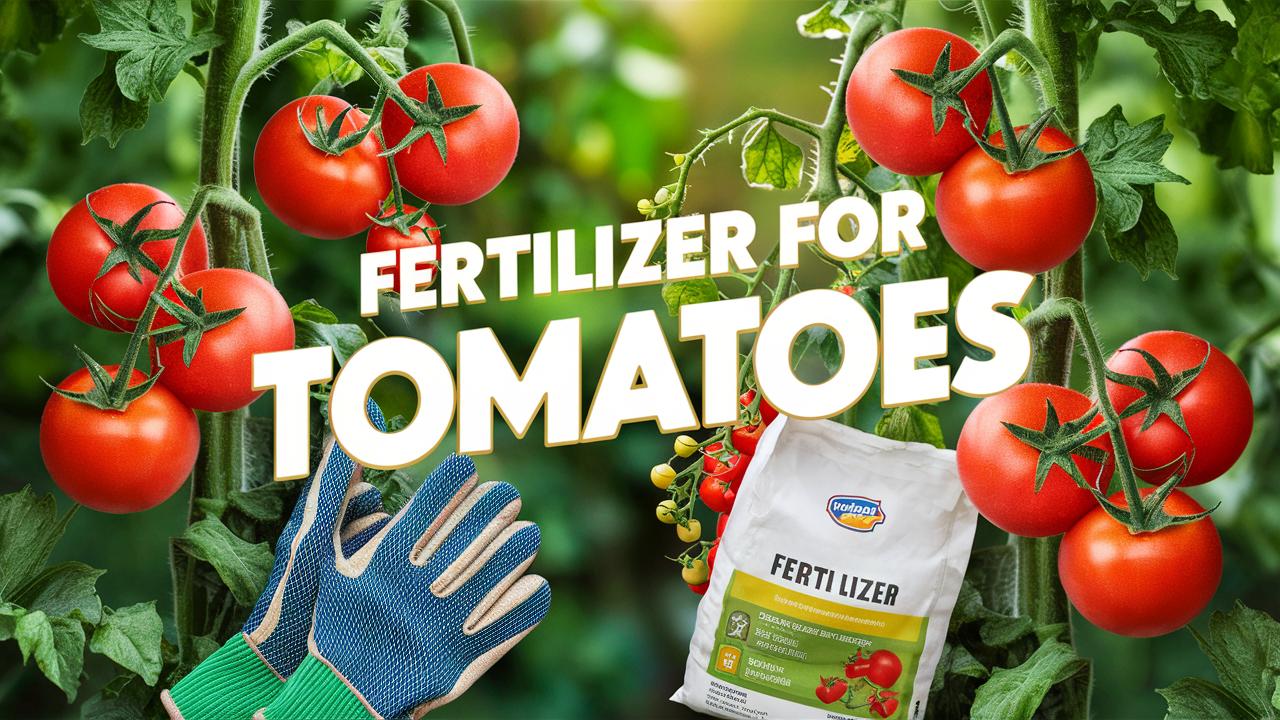Growing healthy and delicious tomatoes can be one of the most rewarding experiences in a gardener’s journey. However, one of the secret ingredients to achieving that bountiful harvest lies in selecting the right fertilizer. If you’ve ever found yourself wandering through the garden center, overwhelmed by the myriad of options on the shelves, you’re not alone.
It’s easy to feel lost amidst the colorful bags, each promising an impressive yield. Fear not! This guide will walk you through the essential steps to choosing the perfect fertilizer for your tomatoes.
Fertilizer For Tomatoes
| Image | Name | Rating | Shop |
|---|---|---|---|
 | Tomato-tone |  | |
 | Tomato Booster |  | |
 | Tomato Magic Plant Food |  |
Tomato-tone
Tomato growers often seek out the best fertilizer options to promote healthy growth and maximize fruit production.
One such option is Espoma Organic Tomato-Tone, a 3-4-6 fertilizer blend with 8% calcium that’s specifically designed to support all types of tomatoes – including both heirloom and hybrid varieties. This formula, made in the USA since 1929, contains natural and organic ingredients enhanced with Bio-tone for optimal results. With its easy-to-use format (just apply it around the drip line every two weeks) you can give your garden a boost that’s both safe for the environment and free of toxic or sludge additives. For added reassurance: Espoma’s Tomato-Tone has been registered as an Organic Input Material, meeting all necessary criteria for organic production.
Tomato Growth Formula
If you’re looking for a fertilizer to boost your tomato plant growth, check out Farmer’s Secret Tomato Booster Fertilizer. This super concentrated formula is specifically designed for optimal performance throughout the life cycle of all types of tomatoes.
With its 3:8:7 ratio and added humic acid, iron, and calcium fortification, this product can help you grow bigger, juicier, and plumper tomatoes in your garden. It’s easy to use too – simply dilute two teaspoons into one gallon of water and apply weekly for the whole growing season. Made with a scientifically-backed formula developed by farmers for growers like you.
Tomato Magic Plant Food
Dynamite Mater Magic – Organic Tomato Fertilizer is a top choice for gardeners looking to maximize their tomato harvest. This OMRI listed fertilizer provides all the necessary nutrients for bigger, juicier tomatoes with higher yields.
In addition to promoting healthy growth and development, Dynamite Mater Magic also contains calcium to help prevent end rot – a common issue that can lead to reduced crop quality. With its versatile formula, this organic tomato fertilizer is suitable for use on a wide range of flowering shrubs, trees, landscape plants, and houseplants – making it an ideal addition to any gardener’s arsenal.
Oxy-Bloom Plus Calcium Rich Liquid Fertilizer
Texas Tomato Food is a top-notch fertilizer designed specifically for larger vegetables like tomatoes. It’s a liquid formula that’s 4.0-2.9-6.7 in NPK terms, making it a balanced nutrient source for your plants.
We recommend this product for its concentrated formula – one gallon can be mixed to make up to 256 gallons of full-strength fertilizer, making it very cost-effective. Additionally, it’s made from natural and organic ingredients like mycorrhizae, worm casts, humic acid, kelp, enzymes, and minerals, which contributes to healthy plant growth. The product is also calcium-rich, helping to prevent blossom-end rot in tomatoes.
Burpee Organic All Purpose Granular Plant Food
The Burpee Organic Tomato & Vegetable Granular Plant Food, 4 lb is a suitable option for gardeners looking to fertilize their tomatoes organically. This product offers long-lasting results and provides essential nutrients in an easy-to-apply granule form.
With its OMRI listing, this fertilizer is certified for organic use, making it a reliable choice for those who prefer natural gardening methods. The formula releases immediate benefits while continuing to provide plant food for up to three months, ensuring superior results throughout the growing season.
Miracle-Gro Shake ‘N Feed Plant Food
Miracle-Gro Shake ‘N Feed Tomato, Fruit & Vegetable Plant Food is a viable option for fertilizing tomatoes. This plant food provides nutrients to both the soil and the plants above it, allowing for healthier growth of your tomato plants. It contains calcium which may help improve fruit quality and length.
The benefits of using Marvel-Gro Shake ‘N Feed include its ease of use – simply apply the product to the soil surface and mix it in, followed by watering to activate the fertilizer – as well as the fact that it continues to nourish your plants for up to 3 months. This means you won’t have to frequently reapply additional fertilizers. Using this product on a regular basis can help keep your tomatoes healthy and thriving throughout the growing season.
Organic Vegetable Fertilizer
This fertilizer, Dr. Earth Organic 5 Tomato, Vegetable & Herb Fertilizer Poly Bag, is designed to promote healthy growth in tomatoes and other vegetables. It’s made with 100% organic and natural ingredients that provide optimal levels of primary plant nutrients.
One of the key features of this product is its ability to feed plants for several months after application. Additionally, it contains beneficial soil microbes and mycorrhizae to promote healthy root development and overall plant health. This makes it a good choice for gardeners who want to grow more abundant crops with higher nutritional value.
Organic Bio Fertilizer Grains Jobe’s Organic Vegetable & Tomato Fertilizer Jobe’s Organic Fertilizer Jobe’s Tomato Plant Food Jobe’s Vegetable Fertilizer Jobe’s Garden Fertilizer Bio Fertilizer For Vegetables and Tomatoes Organic Fertilizer for Veggie Plants
If you’re looking for a reliable fertilizer option for your tomatoes, consider Jobe’s Organics Granular Garden Fertilizer. This product is specifically formulated to supply vegetables and tomatoes with the necessary nutrients for high yields and vibrant foliage.
This 4lb bag of granular fertilizer is OMRI listed by the USDA for organic gardening and contains no synthetic chemicals, making it a safe choice for gardens that prioritize eco-friendly practices. The simple measuring application process also helps prevent over-fertilization, giving you peace of mind in your gardening endeavors.
Understanding Tomato Nutritional Needs
Before delving into the specifics of fertilizers, it’s crucial to understand what tomatoes need nutritionally. Tomatoes thrive on three primary nutrients: nitrogen (N), phosphorus (P), and potassium (K)—commonly referred to as NPK.
Nitrogen supports leafy growth, essential for the overall health of the plant.
Phosphorus is vital for root development and the formation of flowers and fruits.
Potassium aids in overall plant function, including regulating water uptake and improving fruit quality.
Understanding the role of these nutrients can help you select a fertilizer that enhances growth at different stages of the tomato plant’s lifecycle.
Assessing Soil Quality
The first step in selecting a fertilizer is testing your soil. Healthy soil means healthy plants, and this is especially true for tomatoes. A soil test will provide valuable insights into pH levels, nutrient levels, and the overall condition of your soil.
Most tomatoes prefer slightly acidic soil with a pH of around 6.0 to 6.8. If your soil is too acidic or alkaline, it can hinder nutrient absorption. Some local agricultural extension services offer soil testing for free or at a nominal fee, providing you with detailed feedback on what nutrients your soil may be lacking.
Types of Fertilizers
Once you have a grasp on your soil’s condition and tomato’s needs, the next step is to explore the different types of fertilizers available:
1. Granular Fertilizers
Granular fertilizers are dry, often slow-release options that provide nutrients over time as they dissolve in water. They are convenient for gardeners who prefer a “set it and forget it” approach. Typical granular fertilizers for tomatoes highlight an NPK ratio like 5-10-10 or 10-10-10.
How to Use: Apply granular fertilizer when planting seedlings or during the early growing season. Ensure you follow the package instructions to avoid over-fertilizing, which can lead to nutrient burn.
2. Liquid Fertilizers
Liquid fertilizers are another popular choice, particularly for delivering a quick nutrient boost. They usually come in concentrated forms that need to be diluted with water before application.
How to Use: Liquid fertilizers can be applied via watering or through a sprayer. Use them every 2-4 weeks during the growing season, particularly when plants are flowering and fruiting.
3. Organic Fertilizers
For the eco-conscious gardener, organic fertilizers derived from natural sources such as animal manure, compost, or bone meal are an excellent choice. They not only nourish the plants but also improve soil health over time.
Benefits: Organic fertilizers release nutrients more slowly, which can mitigate the risk of nutrient leaching and promote better long-term soil structure.
4. Synthetic Fertilizers
On the other hand, synthetic fertilizers offer a more controlled nutrient profile, enabling precise formulations that can deliver results quickly. However, they often do not improve soil health in the same way that organic fertilizers do.
Considerations: While they can yield quick results, it’s essential to use them wisely to avoid issues like nutrient runoff.
5. Slow-Release Fertilizers
These fertilizers are specially designed to release nutrients gradually, allowing the plants to absorb them over an extended period. They are particularly beneficial for busy gardeners who don’t have time for frequent applications.
Application Tip: Usually applied at the beginning of the growing season, slow-release fertilizers can carry your tomatoes through major growth phases without additional feeding.
NPK Ratios Explained
Understanding NPK ratios can feel daunting, but it’s critical in choosing the right fertilizer for tomatoes. Here’s a quick breakdown of what the numbers on a bag of fertilizer mean:
First Number (Nitrogen): Important for leaf development, useful at the early stage.
Second Number (Phosphorus): Essential for flowering and fruit set.
Third Number (Potassium): Supports overall health and aids in fruit quality.
For tomatoes, a balanced or slightly phosphorus-heavy fertilizer (like 5-10-10 or 10-10-10) during the growing phases is often ideal, particularly since tomatoes require more phosphorus during fruiting.
Timing Your Fertilization
When you fertilize your tomatoes can significantly influence their growth and productivity. Here are some critical points in the growth cycle to consider:
Early Growth Phase
At the start of the growing season, when you’re planting your tomatoes, a fertilizer with higher nitrogen levels can help support robust plant growth. Ideally, choose a balanced fertilizer with a higher first number (nitrogen) for early-stage feeding.
Flowering and Fruiting Stage
Once your tomato plants begin to flower, it’s time to transition to fertilizers higher in phosphorus. Look for fertilizers with lower nitrogen values and higher phosphorus numbers to support fruiting. Regularly apply every 4-6 weeks to ensure ongoing nutrition.
Late Season Care
As harvesting begins, it’s a good idea to back off on nitrogen again since too much nitrogen at this point can lead to lush foliage at the expense of fruit. A fertilizer with more potassium can be beneficial for improving fruit quality and extending the harvest season.
Organic vs. Chemical Fertilizers
Choosing between organic and chemical fertilizers is often a personal choice influenced by several factors including gardening philosophy, environmental concerns, and convenience.
Organic Fertilizers: They enrich the soil, creating a more sustainable ecosystem. This means healthier plants and an eventual build-up of soil organic matter. They are often slower to show results, but the benefits last longer.
Chemical Fertilizers: They can provide rapid results and allow for more control over nutrient ratios. However, improper use can lead to soil degradation and environmental concerns such as water runoff.
Ultimately, both types have their place in gardening, and many gardeners adopt a mixed approach depending on the needs of their tomato plants.
Other Important Nutrients and Amendments
While NPK is critical, tomatoes benefit from additional nutrients. Certain micronutrients contribute significantly to tomato plant health and yield.
Calcium: Prevents blossom end rot, a common issue in tomatoes. Adding lime or bone meal can improve calcium levels.
Magnesium: Important for photosynthesis. Epsom salts (magnesium sulfate) can be applied about once a month as a supplement.
Sulfur and Iron: These additionally help with overall plant health. Incorporating compost or well-balanced organic fertilizers can often supply these nutrients.
Application Techniques
How you apply fertilizer can be just as crucial as the type you choose. Here are some techniques to ensure your tomatoes receive the nutrients they need:
Side-Dressing: This involves applying granular fertilizer in bands alongside the rows of plants. This technique minimizes root disturbance and allows for more efficient nutrient uptake.
Top-Dressing: Doing this involves spreading fertilizer on the soil’s surface around the base of the plant. Be cautious to keep the fertilizer away from the plant stems to prevent burning.
Fertigation: If you are using a drip irrigation system, fertigation allows for efficient delivery of nutrients directly to the roots. Ensure the fertilizer you select is compatible with this system.
Foliar Feeding: Spraying liquid fertilizer directly on the leaves can help with fast nutrient uptake, especially during critical growth phases.
Monitoring Plant Health
As you fertilize your tomatoes, always keep an eye on their health. Signs of nutrient deficiencies or excesses will help guide future decisions about fertilization:
Yellow Leaves: This can indicate nitrogen deficiency. However, too much nitrogen can also cause yellowing, especially on older leaves.
Weak Stems: Can signify a lack of phosphorus or potassium. A weak structure can lead to vulnerability to disease.
Blossom End Rot: Often a sign of inadequate calcium; consider amending with lime or bone meal.
Poor Fruit Development: This may suggest deficiencies in potassium or high nitrogen levels leading to excessive leaf growth.
Conclusion
Choosing the right fertilizer for tomatoes is a nuanced process that takes into account nutrient needs, soil health, growth stages, and environmental factors. An informed approach, considering organic versus chemical and the specific nutritional requirements of your plants, can lead to successful harvests.










